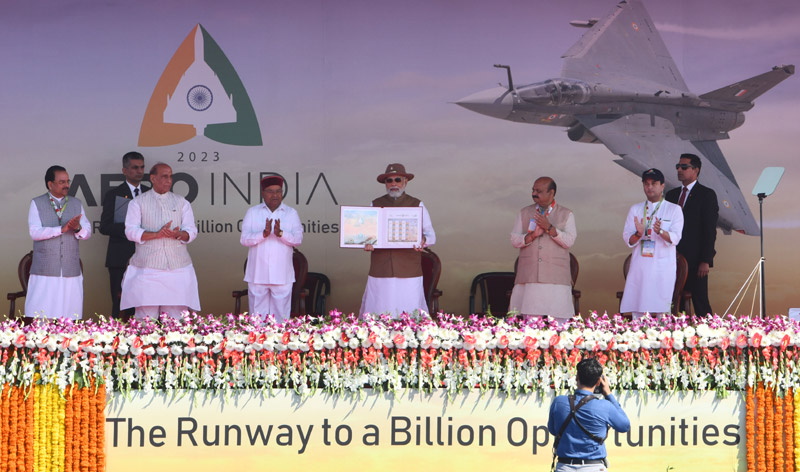The evolving defence & security industrial ecosystem in India
 Maj. Gen. Rambir Mann (retd)
Maj. Gen. Rambir Mann (retd)
The rapidly evolving global politico-strategic environment and the manner in which security challenges are now crystalising before our nation necessitated urgent transformational reforms in our defence industrial edifice. The ministry of defence (MoD) public policy documents have only of late started referring to the concept of defence industrial ecosystem (DIE).
The chapter on ‘Revitalising Defence Industrial Ecosystem through Strategic Partnerships’ in defence production policy 2016 was the first ever official reference of the DIE and it laid the onus of building an extensive DIE on ‘strategic partners’ in the private sector without defining the contours or metrics of the DIE. The defence production policy 2018 also aimed at creating a tiered defence industrial ecosystem and the innovation for defence excellence (iDex) scheme launched by the MoD in April 2018 as well as the setting up of defence innovation hubs nationwide were efforts towards this end. However, nowhere has the ecosystem been defined.

What is an Ecosystem?
Biologically, an ecosystem is a geographic area where plants, animals and other organisms, along with weather and landscape, work together to form a self-sustaining whole. An effective DIE similarly has different entities which come together in meaningful ways to solve shared challenges and meet common objectives. It enables a cumulative network effect for participants and creates greater value than the sum of the parts, driving higher performance and exponential results, through collaboration and co-evolving, leveraging everyone’s collective wisdom.
Such an ecosystem would be driven by a convenor, who would have the ability to influence all the participants and create a facilitating environment, within which all can flourish. The ecosystem's composition and the interactive processes within it are influenced by various internal and external factors and connections, which are constantly evolving and drive significant momentum for innovation and reform. At its core, the DIE encompasses a range of stakeholders, including governmental, commercial, financial, legal, cultural, ethical, scientific and technological entities.
On a global scale, the ecosystem is intertwined with processes of globalization and internationalization, as investment decisions and collaborations span beyond national borders. Regionally, the DIE is shaped by shifts in geopolitical dynamics, strategic partnerships and security concerns, which inform policy development. Nationally, discourse between government and society revolves around critical public issues such as budget allocations and national security. Moreover, sovereignty and autonomy are closely tied to the structure and operations of the defence industry base (DIB) within the broader national industrial landscape. Locally, the relationship between society and the defence industry manifests through workforce provision and employment generation.
The government plays multifaceted roles within the ecosystem as an end-user, regulator, sponsor, developer and facilitator. Meanwhile, industry participants, organized in a hierarchical structure, include ‘primes’ or system integrators, SMEs operating under framework agreements and educational institutions such as universities and colleges, which contribute human resources, knowledge, skills and research expertise. Research councils collaborate with universities for funded research, supported financially by both government and industry. Additionally, industry organizations and associations offer consultancy and support to manufacturers.
Indian Defence Industrial Ecosystem
The need to clearly define and establish a defence ecosystem with a clear holistic strategy, a well-defined roadmap, clear-cut responsibility and accountability, is thus the need of the hour. The government has drawn various action plans to strengthen the country’s defence ecosystem. Indian industry, both public and private, is encouraged to participate in design, development and manufacture of defence systems under ‘Make Procedure’ prescribed in Defence Acquisition Policy-2020 and simplified, wherein provisions to provide financial assistance for prototype development are also incorporated. Over 104 projects have been approved with sanction for 36 projects issued. 18 major platforms have been identified for design and development under various routes and five positive lists of replacement units, subsystems and components which are not allowed to be imported anymore but are to be indigenised. To enable this a portal called sirjandefence.gov in has been created to enable DPSUs/ Services interface with industry and 5,582 items indigenised for INR 3931 crores.
A green channel policy for procurement of defence stores and spares has been launched for awarding green channel status to firms having predefined financial and quality credentials. Grant of green channel certificate provides waiver of pre-dispatch inspection and acceptance of stores under supplier’s guarantee/ warranty against the contracts concluded by various procurement agencies under ministry of defence. Exports have risen from INR 1,522 crores to over INR 21,083 crores in 2023-2024, with the private sector contributing up to 60 per cent. Two Defence Industrial Corridors (DICs)—Uttar Pradesh Defence Industrial Corridor (UPDIC) and Tamil Nadu Defence Industrial Corridor (TNDIC) —have been set up aimed at attracting investment for defence industries, developing the domestic supply chain and strengthening the defence manufacturing ecosystem in the country.
Defence testing infrastructure scheme has been launched to boost domestic defence and aerospace manufacturing with the primary aim to set up greenfield defence testing infrastructure as a common test facility for government assistance to promote indigenous defence production with special focus on participation of micro, small and medium enterprises (MSMEs) and start-ups by bridging gaps in defence testing infrastructure in the country.
iDEX has been launched to bring start-ups and MSMEs to innovate, develop technologies and solve problems related to defence and aerospace, aimed at creation of an ecosystem to foster innovation and technology development in defence and aerospace, research and development (R&D) institutes and academia and provide them grants/ funding and other support to carry out R&D which has potential for future adoption for Indian defence and aerospace needs. DSPUs are having tie–ups with various centres of excellence/ academic institutes like Indian Institutes of Technology (IITs), Indian Institute of Science (IISc), Indian Institutes of Management (IIMs) etc. for various developmental projects.
The Defence Research and Development Organisation (DRDO) has laid down a procedure by which its developed technologies are transferred to industries by entering into Licensing Agreement for Transfer of Technology (LAToT). DRDO has evolved a new ToT policy and procedures with zero ToT fee for its industry partners, development cum production partners (DcPP)/ development partner (DP) and zero royalty for supply to Indian armed forces and government departments. Test facilities have now been opened for industries in DRDO labs. DRDO has launched the technology development fund (TDF) which provides financial support to Indian industries for the design development of innovative defence products. Over 27 projects have been sanctioned with over 63 additional projects under processing. In June 2023, DRDO released 75 priority technology areas/products/systems to encourage Defence R&D in industry, that DRDO will not do.
You must be logged in to view this content.

